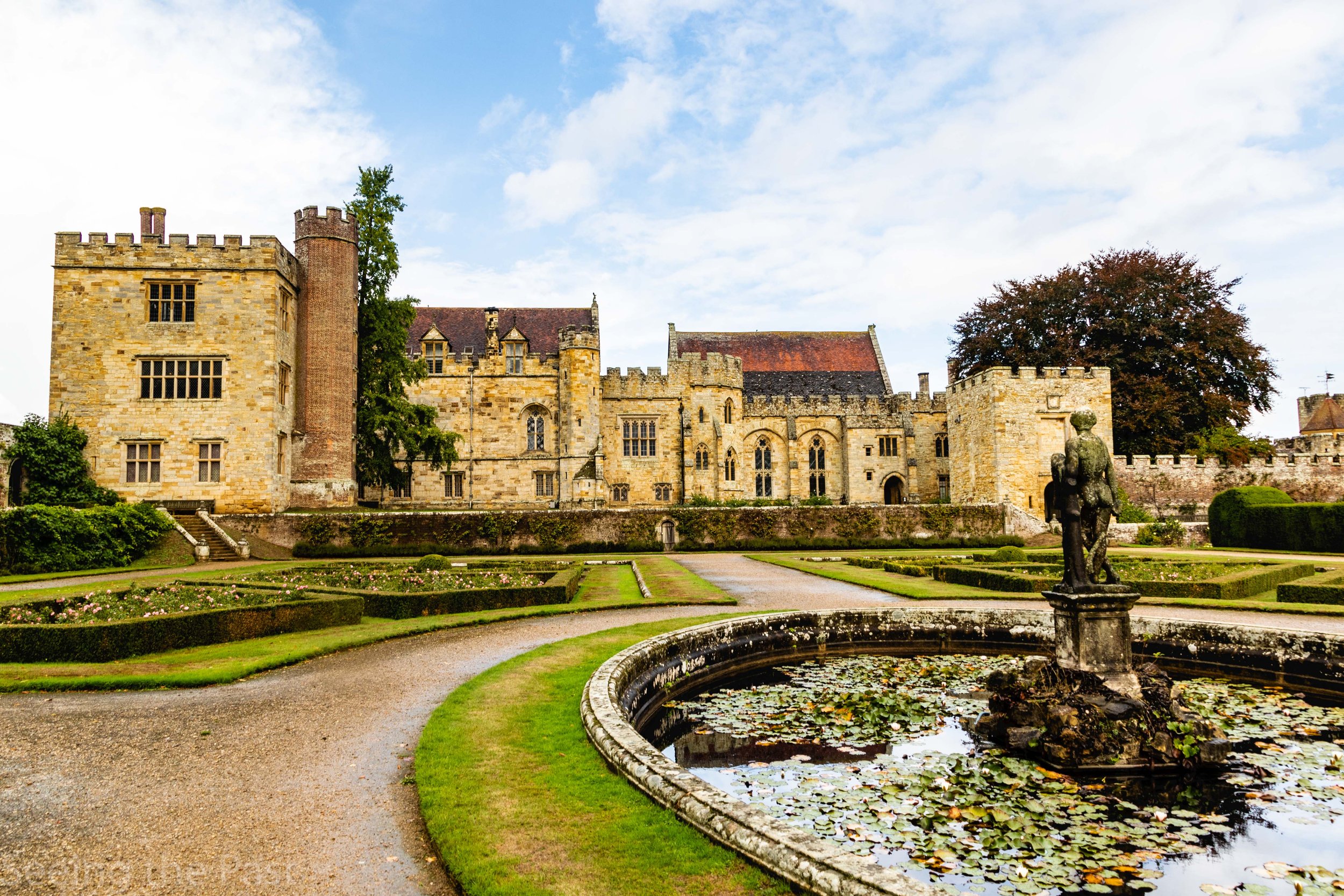Tudor Kent: Royal Connections & Historic Houses
Kent played a pivotal role during the Tudor dynasty (1485-1603), hosting royal visits, fostering powerful families, and witnessing the dramatic religious changes that shaped England. The county's proximity to London and the continent made it strategically important, while its magnificent houses and estates showcase the architectural splendour of the age.

Penshurst Place in Kent, one of the finest examples of Tudor architecture in the county
Royal Kent: The Tudor Dynasty's Intimate Connection
Kent's relationship with the Tudor dynasty was exceptionally close, with the county playing host to several royal residences and the childhood homes of key figures in the Tudor story. Henry VIII in particular maintained strong connections with Kent, making numerous visits to properties across the county and using its harbours for his naval ventures.
Kent's significance to the Tudors cannot be overstated - it was a county that provided them with both loyal subjects and, at times, fierce opposition. The county's proximity to London made it a favoured retreat for courtiers seeking to build impressive country estates within easy reach of the capital, while its strategic coastal position ensured its continued importance for trade and defense.
Henry VIII and Anne Boleyn in Kent
Perhaps the most famous Tudor connection to Kent comes through Anne Boleyn and her family seat at Hever Castle. It was here, in this moated castle with its magnificent gardens, that Henry VIII courted the woman who would become his second wife and trigger the momentous break with Rome.
It is traditionally believed that Henry VIII visited Hever Castle on several occasions during his courtship with Anne Boleyn. Though the castle was relatively small by royal standards, its significance in the Tudor story is immense as the childhood home of the woman whose marriage to Henry VIII would change the course of English history.
Kent's importance to Henry VIII extended beyond his marital pursuits. The king invested heavily in the county's defences, particularly its coastal fortifications. After his break with Rome, the threat of invasion from Catholic powers became very real, and Henry commissioned a series of artillery forts along the Kent coast, including Deal, Walmer, and Sandgate Castles.
Tudor Mansions and Great Houses of Kent
The Tudor period saw a proliferation of magnificent houses across Kent, as wealthy courtiers and local gentry sought to display their status and wealth through impressive architectural statements. These buildings, many of which survive today, provide us with tangible links to the Tudor past.
Hever Castle
Dating back to the 13th century, Hever Castle gained its greatest significance as the childhood home of Anne Boleyn. The castle features magnificent Tudor interiors, including a collection of Tudor portraits and Anne Boleyn's prayer books. After the Boleyn family fell from grace, the castle was given to Anne of Cleves as part of her divorce settlement from Henry VIII.
Today, visitors can explore the panelled rooms where history was made and view personal items belonging to Anne Boleyn. The castle also houses one of the finest collections of Tudor portraits outside the National Portrait Gallery, including depictions of all six of Henry VIII's wives.
Penshurst Place
Penshurst Place represents one of the finest examples of a fortified manor house in England. Its magnificent Baron's Hall dates from 1341, but the house saw significant development during the Tudor period when it came into royal ownership. Henry VIII used Penshurst as a hunting lodge, and it later became the property of Edward VI's tutor, Sir William Sidney.
The Sidney family, who continue to own Penshurst today, were prominent Tudor courtiers. Sir Henry Sidney was a close childhood friend of Edward VI, while his son, Sir Philip Sidney, became one of the most celebrated poets of the Elizabethan age. The house contains important Tudor furniture, tapestries, and portraits.
Knole House
Knole House in Sevenoaks is one of England's largest houses and a superb example of Tudor architecture. Originally an archbishop's palace, it was appropriated by Henry VIII in 1538 during the Dissolution of the Monasteries. It was later granted to Thomas Sackville, whose descendants would become the Earls and Dukes of Dorset.
The house contains a remarkable collection of Stuart furniture, silver, and textiles. Its famous Knole Sofa, dating from the early 17th century, has given its name to a style of furniture still produced today. The scale and grandeur of Knole represent the peak of Tudor architectural ambition.
Ightham Mote
Though originally medieval in origin, Ightham Mote received significant Tudor additions. This moated manor house offers visitors a glimpse into the domestic life of the Tudor gentry. The house's Tudor chapel, with its impressive painted ceiling, is particularly noteworthy.
Did You Know?
It is Henry VIII who is said to have first called Kent the 'Garden of England'. According to historical accounts, after sampling cherries in Flanders, the king ordered Britain's first cherry orchard to be planted in Teynham, Kent. The county's fertile soil and mild climate made it perfect for growing fruit and hops.
Religious Reformation in Kent
The Tudor period witnessed dramatic religious changes, and Kent was often at the forefront of these transformations. As a county with strong ecclesiastical ties through Canterbury Cathedral and Rochester Cathedral, Kent experienced the Reformation in profound ways.
Canterbury, as the seat of the Archbishop and the heart of English Christianity, became a focal point for religious change. The shrine of Thomas Becket, which had drawn pilgrims for centuries, was destroyed on Henry VIII's orders in 1538. This act symbolised the dramatic shift in religious practice and the crown's assumption of supreme religious authority.
Kent's religious houses, like those across England, were dissolved during the 1530s. The magnificent Canterbury Cathedral Priory, St Augustine's Abbey, and many smaller religious establishments were closed, their lands and wealth appropriated by the crown. Some of these buildings were repurposed, while others were left to decay or were dismantled for building materials.
Timeline of Tudor Kent
1497
The Cornish Rebellion passes through Kent on its way to London, highlighting the county's strategic importance
1520
Henry VIII departs from Dover for the Field of Cloth of Gold meeting with Francis I of France
1533
Anne Boleyn, raised at Hever Castle in Kent, is crowned Queen of England
1538
Dissolution of the Monasteries affects Kent's religious houses, including St Augustine's Abbey in Canterbury
1539-40
Henry VIII builds a chain of coastal defences in Kent, including Deal and Walmer Castles
1554
Sir Thomas Wyatt leads a rebellion in Kent against Queen Mary's Spanish marriage
1558
Elizabeth I becomes queen, beginning a period of prosperity for many Kentish families
1580s
Kent's shipbuilders contribute significantly to the vessels that would defeat the Spanish Armada
The Reformation was not universally accepted in Kent, and the county saw significant unrest. Most notably, Sir Thomas Wyatt the Younger led a rebellion in 1554 against Queen Mary's Spanish marriage plans. Beginning in Maidstone, the rebellion gained significant support across the county before its eventual defeat. Wyatt's rebellion demonstrates the complex religious and political dynamics at play in Tudor Kent.
Maritime Kent in the Tudor Age
Kent's extensive coastline made it crucial to Tudor England's maritime ambitions. The Cinque Ports, though declining from their medieval heyday, still played a role in naval affairs, while the development of royal dockyards would lay the foundation for Kent's later naval importance.
Dover, Sandwich, and other Kentish ports witnessed increased naval activity during the Tudor period. The threat from continental powers, particularly Spain during the latter half of the 16th century, necessitated a strong coastal defence strategy. The chain of artillery forts built by Henry VIII represented a revolution in military architecture, designed specifically to withstand and deliver cannon fire.
Kent's shipbuilding industry also flourished during this period. Local shipwrights contributed to the vessels that would form England's navy, including those that faced the Spanish Armada in 1588. The expertise developed in Kent during this period would later support the growth of the Royal Dockyards at Chatham in the following century.
Tudor Legacy in Kent's Landscape
The Tudor impact on Kent's landscape remains visible today. Beyond the grand houses already mentioned, the period saw developments in agriculture and industry that shaped the county's character.
The expansion of hop growing during the Tudor period established a tradition that would come to define Kent's rural character for centuries. The distinctive oast houses (though most surviving examples date from later periods) have their origins in this Tudor agricultural innovation.
The Tudor period also saw the expansion of timber-framed construction across Kent. Many towns and villages retain excellent examples of Tudor domestic architecture, with Chiddingstone, Cranbrook, and parts of Canterbury offering particularly well-preserved streetscapes.
Tudor Kent in Literature
Kent features prominently in the work of Elizabethan writers. Shakespeare's history plays reference historical events in Kent, while Kentish settings appear in works like "The Merry Wives of Windsor." Edmund Spenser, in his epic poem "The Faerie Queene," was influenced by his time in Kent, where he had family connections in East Kent.
Visiting Tudor Kent Today
For those wishing to explore Kent's Tudor heritage, the county offers a wealth of sites that bring this fascinating period to life:
- Hever Castle - Experience Anne Boleyn's childhood home with its Tudor portraits and gardens
- Penshurst Place - Explore one of England's most complete Tudor houses
- Knole - Marvel at the scale and grandeur of this enormous Tudor palace
- Deal and Walmer Castles - Visit Henry VIII's coastal defences
- Canterbury Cathedral - Witness the architectural changes brought by the Reformation
- Ightham Mote - Discover a charming moated manor with Tudor additions
Many of these properties host Tudor-themed events throughout the year, offering opportunities to experience Tudor crafts, cuisine, and entertainment firsthand.
Conclusion: Kent's Tudor Heritage
The Tudor period left an indelible mark on Kent's landscape, architecture, and cultural identity. From magnificent houses to coastal defences, from religious transformation to agricultural innovation, the legacy of this dynamic period remains visible across the county.
Kent's Tudor connections offer us a window into one of the most transformative periods in English history. Through the preservation of buildings, landscapes, and stories, we can continue to explore and understand the complex world of Tudor England and Kent's crucial role within it.
For genealogists and family historians, Kent's Tudor records provide valuable resources for tracing ancestors from this period. Parish registers, which began during Henry VIII's reign, offer insights into ordinary lives, while estate records document the activities of those connected to the great houses of Tudor Kent.
